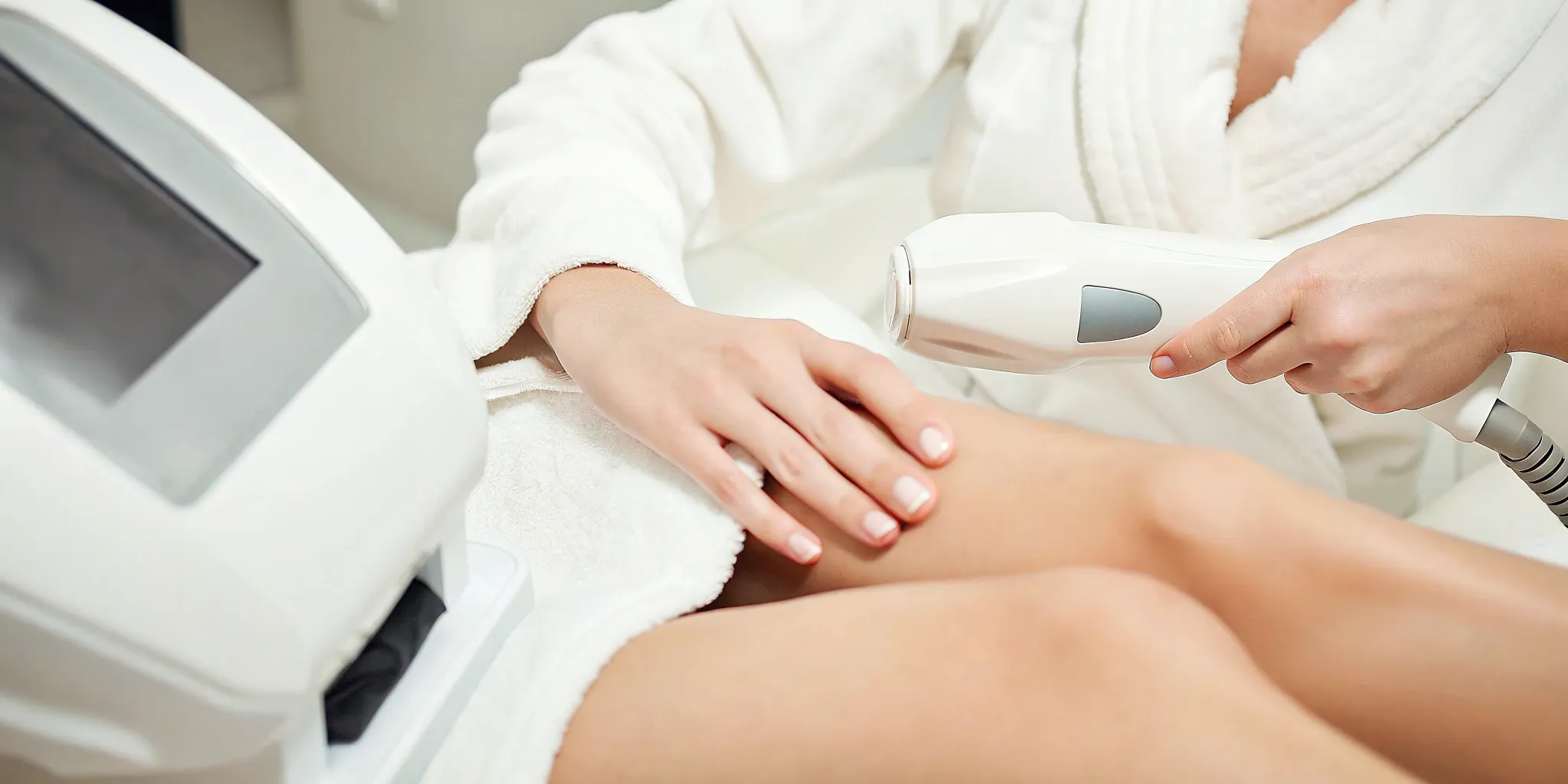Ready for a change? Complete color tattoo removal offers a chance to rewrite your skin’s story. At Ultimate Image MedSpa in Texas, we specialize in helping clients achieve a clear canvas, free from unwanted ink. Using state-of-the-art laser technology, we can effectively target and remove all tattoo colors, even the most stubborn shades. This article provides a comprehensive guide to complete color tattoo removal, covering everything from the science behind the process to what you can expect during and after treatment. We’ll also discuss the importance of choosing a qualified provider and how Ultimate Image MedSpa can help you achieve your aesthetic goals.
Key Takeaways
- Complete tattoo removal is possible: Modern laser technology can effectively remove all tattoo ink colors, giving you a fresh start. Your individual results depend on factors like the tattoo’s age, colors, and your skin type.
- The process takes time and care: Tattoo removal requires multiple laser sessions and diligent aftercare. Protecting your skin from the sun and following your provider’s instructions are crucial for the best outcome.
- A qualified provider is essential: Choose a specialist experienced in laser tattoo removal who can create a personalized treatment plan. Ask questions during your consultation to understand the process and feel comfortable with your decision.
What is Complete Color Tattoo Removal?
Complete color tattoo removal means just that—erasing a tattoo entirely, regardless of its colors. While older removal methods struggled with certain inks, especially vibrant shades like greens and blues, advancements in laser technology now make complete removal a realistic goal. This is a significant leap from the past, when fading a tattoo was often the best you could hope for. Now, you can expect your skin to return to its natural state, free of unwanted ink.
How Laser Tattoo Removal Breaks Down Ink
So, how does this process work? Laser tattoo removal uses focused light energy to target tattoo ink particles beneath the skin. These powerful lasers shatter the ink into tiny fragments, which your body’s immune system then recognizes as foreign substances and gradually eliminates. Think of it as your body’s natural cleaning crew sweeping away the unwanted ink debris. This process happens gradually over several sessions, allowing your skin to heal between treatments. Learn more about tattoo removal.
Advanced Laser Removal Technologies
Tattoo removal has come a long way. We’ve moved beyond older, less precise methods to sophisticated laser technologies that deliver safer and more effective results. These advancements include lasers with varying wavelengths, allowing practitioners to target different ink colors with greater precision. For example, the LightSense™ laser, known for its ultra-low energy levels, offers a more comfortable experience with less discomfort during treatments. These targeted approaches minimize potential side effects and maximize the chances of complete ink removal. Discover the latest in tattoo removal technology.
Tattoo Removal Methods
Deciding to remove a tattoo is a big step, so understanding your options is important. Laser tattoo removal is the most common and effective method, but other techniques exist. Each has its own pros and cons. Let’s explore the different tattoo removal methods available.
Laser Removal: The Gold Standard
Laser tattoo removal is the go-to method for most patients and practitioners. This technique uses focused pulses of light energy to break down the tattoo ink into smaller fragments. Your body’s immune system then naturally processes and eliminates these fragmented particles. Because the process relies on your body’s natural mechanisms, it’s gradual and typically requires multiple sessions for complete removal.
Advancements in laser technology have made the process more efficient and precise. Different laser wavelengths can target various ink colors, allowing practitioners to tailor the treatment to your specific tattoo. Companies like Removery specialize in removing complex, multicolored tattoos, and report effective removal across a spectrum of ink colors and skin tones.
Other Tattoo Removal Techniques
Besides laser removal, several other methods exist, though they are generally less effective and may carry higher risks. Dermabrasion involves sanding down the skin’s surface to remove the tattooed layers. Chemical peels use acidic solutions to achieve a similar effect. Surgical excision, a more invasive procedure, involves cutting out the tattooed skin and stitching the remaining skin together. These options may be less invasive than surgical excision, but they often require extended use, and results can vary.
Tattoo removal creams often contain ingredients like trichloroacetic acid (TCA) to break down ink. However, these creams can be unpredictable, and results vary significantly. Home removal methods are strongly discouraged because of the potential for skin damage and infection. Consulting a qualified professional is always the safest approach for any tattoo removal procedure.
Factors Affecting Tattoo Removal
Several factors influence the tattoo removal process, impacting the number of sessions needed and the overall outcome. Understanding these factors helps set realistic expectations before starting treatment. At Ultimate Image MedSpa, we assess these factors during your consultation to create a personalized tattoo removal plan.
Ink Colors and Removal Difficulty
Different ink colors respond differently to laser treatments. Darker inks, especially black, absorb laser energy more effectively, making them generally easier to remove. Lighter colors, such as yellow, green, and pastel shades, can be more challenging. This is because different laser wavelengths target specific ink colors, and some pigments are more resistant to breakdown. For example, black ink is easier to remove than colors like yellow or purple. During your consultation at Ultimate Image MedSpa, we’ll discuss how your tattoo’s color palette might affect the removal process.
Tattoo Age, Location, and Size
Older tattoos are often easier to remove than newer ones because the ink has had more time to break down naturally. The location of the tattoo on your body also plays a role. Tattoos located closer to the heart, where circulation is better, tend to respond better to treatment. Similarly, smaller tattoos generally require fewer sessions than larger, more complex designs. Factors like tattoo size, color, age, and location will influence the number of sessions needed for complete removal.
Skin Type and Tone
Your skin type and tone are important considerations in tattoo removal. Lighter skin tones typically see faster results because the contrast between the ink and skin allows for better laser targeting. Darker skin tones require more specialized lasers and techniques to avoid potential side effects like hyperpigmentation (darkening of the skin) or hypopigmentation (lightening of the skin). Tattoo removal for darker skin tones requires specific considerations, and we address these at Ultimate Image MedSpa. We use advanced laser technology suitable for all skin types, ensuring safe and effective treatment for everyone.
The Tattoo Removal Process
Deciding to remove a tattoo is a big step. Understanding the process can help you feel confident and prepared as you begin your journey to a blank canvas. At Ultimate Image MedSpa, we prioritize personalized care, ensuring you’re comfortable and informed every step of the way. This section breaks down what you can expect during the tattoo removal process.
Your Consultation and Assessment
Your first step is a personal consultation with one of our skilled specialists. We’ll carefully evaluate your tattoo, considering factors like its size, the colors used, its age, and its location on your body. We’ll also assess your skin type and discuss your desired outcome. This thorough assessment allows us to create a customized treatment plan tailored to your specific needs, ensuring the most effective and safe tattoo removal possible. This is also a great opportunity to ask any questions and address any concerns.
Treatment Sessions and Timeline
Tattoo removal typically involves multiple sessions. The exact number depends on factors we discussed above, like the ink density, color complexity, and your individual skin’s response to the treatment. Most tattoos require between six and twelve sessions for complete removal. During each session, advanced laser technology targets the tattoo ink, breaking it down into tiny particles that your body can then eliminate. We space these sessions several weeks apart to allow your skin to heal properly between treatments. For more details on what to expect, check out this helpful resource on the tattoo removal process.
Pain Management
We understand that pain is a common concern when considering tattoo removal. While the sensation can vary, many describe it as similar to a rubber band snapping against the skin. At Ultimate Image MedSpa, we prioritize your comfort. We offer various pain management options, including topical numbing creams, to minimize any discomfort during the procedure. We’ll discuss these options with you during your consultation to determine the best approach for you. For more information on managing discomfort during tattoo removal, take a look at this article on common tattoo removal myths.
How Many Tattoo Removal Sessions Do I Need?
Getting rid of a tattoo isn’t an overnight process. It takes time, and the number of sessions varies from person to person. Let’s explore why.
Factors Influencing Session Count
Several factors play a role in how many tattoo removal sessions you’ll need. Think of your tattoo as unique—its size, colors, age, and even its location on your body all affect the removal process. Larger tattoos take longer to treat than smaller ones, and certain ink colors, like vibrant blues and greens, are more stubborn than black ink. Older tattoos sometimes respond faster to treatment, while a tattoo’s location can influence how efficiently your body removes the broken-down ink. Your skin type and tone also play a role.
Most tattoos require between six and twelve sessions for complete removal. This is an average, though. Some might require fewer sessions, while others might need more. During your consultation at Ultimate Image MedSpa, we’ll assess your tattoo and create a personalized treatment plan.
Setting Realistic Expectations
Tattoo removal is a gradual process. The laser breaks down the ink, and then your body slowly absorbs and eliminates it. This means you won’t see instant results. It’s more like working towards a long-term goal—consistency and patience are essential.
While it’s natural to want to see your tattoo disappear quickly, remember it’s a commitment. Focus on the long-term benefits of tattoo-free skin to stay motivated. Modern tattoo removal techniques have high success rates, but various factors can influence the results. It’s important to have realistic expectations about the process and potential outcomes. We’re here to support you. Contact us to schedule a consultation and discuss your tattoo removal goals.
Aftercare and Recovery
After your tattoo removal session, proper aftercare is essential for comfortable healing and optimal results. Think of aftercare as a partnership with your provider—they’ve done their part, and now it’s your turn to ensure the best possible outcome. Following these guidelines can minimize discomfort and help your skin bounce back beautifully.
Post-Treatment Care
Immediately after your session, the treated area might feel similar to a sunburn. Your practitioner will provide specific instructions, but generally, you’ll want to keep the area clean and protected. A simple routine of gentle cleansing with mild soap and water is usually sufficient. Avoid harsh scrubbing or perfumed products that could irritate your skin. Your provider might also recommend applying a thin layer of antibiotic ointment and keeping the area covered with a bandage for a few days. For a detailed guide on post-treatment care, check out these tips from TakeTatt. Over the next several weeks, your body will naturally work to eliminate the broken-down ink particles, and you’ll gradually see the tattoo fade. Remember, patience is key during this process. Consistent aftercare and allowing adequate time for healing between sessions are crucial for successful tattoo removal.
Managing Side Effects and Healing
Some temporary side effects, such as redness, swelling, and minor blistering, are normal after tattoo removal. Applying a cool compress can help soothe the treated area and reduce any discomfort. Affiliated Dermatology offers helpful information on the typical recovery timeline and what to expect during the healing process. Protecting your skin from the sun is paramount during this time, as sun exposure can interfere with healing and potentially lead to complications. Always apply a broad-spectrum sunscreen with a high SPF to the treated area, even on cloudy days. ThinkSano provides a comprehensive guide to tattoo removal aftercare, including tips for managing side effects and promoting healthy healing. If you experience any unusual or concerning side effects, don’t hesitate to contact your tattoo removal provider. They can address your concerns and provide guidance specific to your situation. Remember, open communication with your provider is essential throughout the entire tattoo removal journey.
Potential Risks and Complications
While laser tattoo removal is generally safe, it’s important to understand the potential short-term side effects and long-term considerations before starting treatment. Knowing what to expect helps you make informed decisions and prepare for the process.
Short-Term Side Effects
Immediately after a laser tattoo removal session, you might experience reactions similar to a mild sunburn, including redness, swelling, and tenderness around the treated area. Proper aftercare is crucial for minimizing these effects and promoting healthy healing. For the next six to eight weeks, your body will work to eliminate the broken-down ink, resulting in gradual fading. This healing process is essential, so be patient and follow your provider’s aftercare instructions. Avoid sun exposure during this time, as it can interfere with fading and potentially cause complications.
Long-Term Considerations
Although laser tattoo removal has high success rates, several factors influence the final outcome. These factors can include the tattoo’s age, size, location, and ink colors. Complete removal isn’t always possible, especially with larger, multicolored, or deeply layered tattoos. It’s important to have realistic expectations and discuss your goals with a qualified provider. Diligent aftercare plays a vital role in minimizing the risk of long-term complications, such as scarring or changes in skin pigmentation. By understanding the potential risks and following your provider’s recommendations, you can improve your chances of a successful tattoo removal experience.
Choosing a Qualified Tattoo Removal Provider
Finding the right tattoo removal provider is the most important step in your journey. A qualified specialist can make all the difference in achieving a safe and effective outcome. This section helps you understand what to look for and what questions to ask during your consultation.
What to Look for in a Specialist
Start by looking for a provider who is a dermatologist or another qualified medical professional specializing in laser tattoo removal. Experience matters, especially with different ink colors and skin types, so be sure to inquire about their expertise with various tattoos. Confirm the provider uses appropriate laser wavelengths to target the specific colors in your tattoo. This is crucial for successful removal. Finally, check that the clinic is clean, modern, and adheres to all safety standards. Your comfort and safety should be a top priority. For clients in Texas, Ultimate Image MedSpa offers safe and effective tattoo removal services.
Questions for Your Consultation
Your consultation is your opportunity to gather information and ensure the provider is the right fit. Come prepared with questions. Ask about the specific type of laser technology they use and how it works on different ink colors. Inquire about the estimated number of sessions needed for complete removal, based on your tattoo’s size, location, and colors. This helps you set realistic expectations. It’s also important to discuss potential side effects, aftercare procedures, and the overall cost. Tattoo removal is a journey, so don’t hesitate to discuss the emotional aspects of the process and any concerns you may have. A qualified provider will address your questions thoroughly and provide a personalized treatment plan. You can schedule a consultation to discuss your tattoo removal goals with a specialist.
Common Tattoo Removal Misconceptions
Debunking Myths
When it comes to tattoo removal, several misconceptions can make the process seem confusing. Let’s clear up some common myths:
- Myth: Tattoos vanish in one session. It’s tempting to think one laser treatment will erase your tattoo, but that’s rarely the case. Most tattoos require multiple sessions for complete removal. Factors like the tattoo’s size, color, age, and depth all influence how many treatments you’ll need.
- Myth: Tattoo removal doesn’t work. While older removal methods may have had limitations, laser tattoo removal technology has advanced significantly. It is possible to achieve significant fading, often leaving little trace of the original ink. It’s important to have realistic expectations and understand that complete removal depends on a variety of factors.
- Myth: Tattoo removal is a quick fix. Effective tattoo removal takes time. It’s not an overnight solution and requires a commitment to multiple sessions spaced weeks apart. Before starting treatment, consider the time involved and plan accordingly.
- Myth: DIY methods are just as effective. Home remedies for tattoo removal might seem appealing, but they can be risky and ineffective. Professional treatments use advanced lasers to break down the ink safely and effectively. DIY methods can cause skin damage, scarring, and infection, making professional removal even more challenging.
- Myth: Removal is more painful than getting the tattoo. Pain is subjective. While some find removal more uncomfortable, others report it as less painful than getting the tattoo. Modern laser technology often incorporates cooling methods to minimize discomfort. Your individual pain tolerance and the specific removal method used will influence your experience.
Maximizing Your Results
Getting the best results from your color tattoo removal journey involves more than just showing up for your appointments. It requires a holistic approach, combining in-office treatments with a commitment to certain lifestyle choices. This two-pronged approach can significantly impact your outcome and help you achieve a clear canvas.
Lifestyle Factors and Success
Think of tattoo removal as a partnership between you and your practitioner. While they provide the technical expertise and advanced tools, you play a crucial role in supporting your body’s natural healing process. One of the most important factors is protecting your skin from the sun. Consistent and diligent sun protection is crucial both during and after treatment to minimize the risk of hyperpigmentation (darkening of the skin) or hypopigmentation (lightening of the skin). Think hats, sunscreen, and protective clothing, especially for areas exposed to direct sunlight.
Equally important is your commitment to the aftercare process. Proper care helps prevent complications and ensures your skin heals well after each session. Following your practitioner’s instructions diligently will minimize discomfort and optimize the fading process. Remember, large, colorful tattoos often require a long-term commitment, so patience and persistence are key. Trust the process, and stay consistent with your aftercare routine.
Combining Treatments for Optimal Outcomes
Understanding the science behind tattoo removal can empower you to make informed decisions about your treatment plan. Laser tattoo removal works by using specific wavelengths of light to target and break down ink particles. These fragmented particles are then gradually eliminated by your body’s immune system. Because different ink colors absorb different wavelengths of light, some colors are more challenging to remove than others. This is where advanced laser technologies and combination treatments come into play.
Companies like Removery specialize in removing all ink colors from all skin types using advanced laser technology. Often, combining different laser techniques within a single session can be more effective than relying on a single wavelength. This targeted approach allows practitioners to address various ink colors and depths more efficiently, potentially leading to faster and more complete removal. Discuss these options with your provider to determine the best approach for your specific tattoo.
Frequently Asked Questions
Is laser tattoo removal safe for all skin tones? Yes, laser tattoo removal is safe for all skin tones, but darker skin requires more specialized lasers and techniques. At Ultimate Image MedSpa, we use advanced lasers suitable for all skin types to minimize risks like hyperpigmentation (skin darkening) or hypopigmentation (skin lightening).
How long does the tattoo removal process take? The number of sessions needed varies depending on several factors, including the tattoo’s size, colors used, age, and location. Most tattoos require between six and twelve sessions, spaced several weeks apart to allow for proper healing. During your consultation, we’ll assess your tattoo and provide a personalized timeline.
Does laser tattoo removal hurt? Many describe the sensation as similar to a rubber band snapping against the skin. At Ultimate Image MedSpa, we prioritize your comfort and offer pain management options, such as topical numbing creams, to minimize discomfort during the procedure.
What can I expect after a tattoo removal session? The treated area might feel like a mild sunburn immediately after the session. We’ll provide detailed aftercare instructions, which typically involve keeping the area clean, protected, and moisturized. Some redness, swelling, and minor blistering are normal and usually subside within a few days.
How do I choose a qualified tattoo removal provider? Look for a provider with experience in laser tattoo removal, ideally a dermatologist or other qualified medical professional. Ask about the types of lasers they use, their experience with different ink colors and skin types, and their safety protocols. A thorough consultation is essential for discussing your goals, addressing your concerns, and developing a personalized treatment plan.







